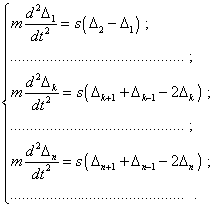Materials.Technologies.Tools |
20 |
S.B. Karavashkin |
|
|
|
Materials.Technologies.Tools |
20 |
S.B. Karavashkin |
|
|
|
3. Analysis and check of results yielded for free vibrations The expressions describing free vibrations are known to be solutions of a homogeneous modelling system of equations. With it the line is supposed to be having a definite internal energy that provides the non-trivial solutions for this system. In infinite lines, even with small natural vibration of elements, the general internal energy of an elastic system is infinite, so to substantiate the physics of a natural vibration process, it is expedient to proceed not from the general energy of material bodies system but from the line elements vibration energy being finite in this case. Considering it, to find solutions of homogeneous system, it is necessary to assume not simply initial conditions but some function describing the vibration of some element selected from a line, satisfying the definite initial conditions. In the present study, select the kth element whose shift varies in time as a simple harmonic function |
| (35) |
where Ak is the vibration amplitude in the line. Indeed, the same as in case of affecting force, we could
present 3.1. Semi-finite line The homogeneous modelling system for semi-infinite elastic line is similar to (4) in absence of external force, i.e. |
 |
(36) |
The same as (4), it has three solutions corresponding to the periodical regime at |
| (37) |
aperiodical at |
| (38) |
and critical at |
| (39) |
regimes relatively. In the periodical regime, by contrast with the related regime for forced vibrations, we can see a standing wave with the amplitude depending both on elements location in the line determined by index i and on the number k of the selected element. For the solutions of homogeneous equations it is quite unexpected, provided that we choose the index k arbitrarily and do not affect the kth element, because in the given problem namely free vibrations are studied. None the less, the vibration amplitude and phase in the whole line depend on the chosen parameters, which is determined by the denominator of (37). And at |
| (40) |
we can see the resonance in the line. Because of it, the vibration amplitude becomes infinite, while the vibration amplitude of the kth element remains finite and corresponds to the given initial conditions. From the physical view it evidences that all free vibrations result from the after-effect of somewhat external excitation forces. And the vibration parameters that we study depend namely on the characteristics of these forces and on the point of their application. Actually, we can see from the solution (37) that specifying any frequencies within the limits of periodical regime and choosing the element number as that kth, we can yield the standing wave of any amplitude and phase, because the spectrum of allowed frequencies of free vibrations is continuous for a semi-finite line. It means, the process of free vibration in a semi-finite line to be determined, we need to know the characteristics of the preceded external affection. Check the conformity of (37) to (36). It is sufficient for it to check, whether the identity is established in the first and arbitrary ith equations of the system. For the first equation of system, on its left side we yield |
| (41) |
and on the right side |
| (42) |